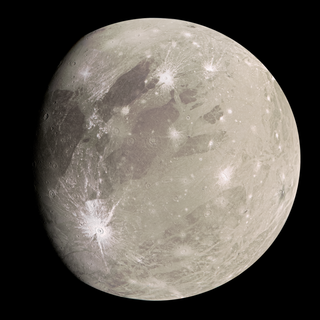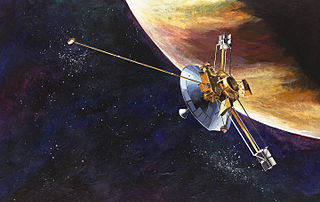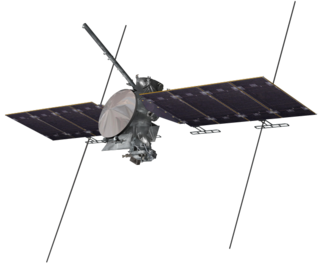
Europa, or Jupiter II, is the smallest of the four Galilean moons orbiting Jupiter, and the sixth-closest to the planet of all the 95 known moons of Jupiter. It is also the sixth-largest moon in the Solar System. Europa was discovered independently by Simon Marius and Galileo Galilei and was named after Europa, the Phoenician mother of King Minos of Crete and lover of Zeus.

Ganymede, or Jupiter III, is the largest and most massive natural satellite of Jupiter as well as the largest in the Solar System, being a planetary-mass moon. It is the largest Solar System object without a substantial atmosphere, despite being the only moon in the Solar System with a substantial magnetic field. Like Titan, Saturn's largest moon, it is larger than the planet Mercury, but has somewhat less surface gravity than Mercury, Io or the Moon due to its lower density compared to the three.

Ulysses was a robotic space probe whose primary mission was to orbit the Sun and study it at all latitudes. It was launched in 1990 and made three "fast latitude scans" of the Sun in 1994/1995, 2000/2001, and 2007/2008. In addition, the probe studied several comets. Ulysses was a joint venture of the European Space Agency (ESA) and the United States' National Aeronautics and Space Administration (NASA), under leadership of ESA with participation from Canada's National Research Council. The last day for mission operations on Ulysses was 30 June 2009.

The Jupiter Icy Moons Orbiter (JIMO) was a proposed NASA spacecraft designed to explore the icy moons of Jupiter. The main target was Europa, where an ocean of liquid water may harbor alien life. Ganymede and Callisto, which are now thought to also have liquid, salty oceans beneath their icy surfaces, were also targets of interest for the probe.

Juno is a NASA space probe orbiting the planet Jupiter. It was built by Lockheed Martin and is operated by NASA's Jet Propulsion Laboratory. The spacecraft was launched from Cape Canaveral Air Force Station on August 5, 2011 UTC, as part of the New Frontiers program. Juno entered a polar orbit of Jupiter on July 5, 2016, UTC, to begin a scientific investigation of the planet. After completing its mission, Juno will be intentionally deorbited into Jupiter's atmosphere.

The exploration of Jupiter has been conducted via close observations by automated spacecraft. It began with the arrival of Pioneer 10 into the Jovian system in 1973, and, as of 2023, has continued with eight further spacecraft missions in the vicinity of Jupiter. All of these missions were undertaken by the National Aeronautics and Space Administration (NASA), and all but two were flybys taking detailed observations without landing or entering orbit. These probes make Jupiter the most visited of the Solar System's outer planets as all missions to the outer Solar System have used Jupiter flybys. On 5 July 2016, spacecraft Juno arrived and entered the planet's orbit—the second craft ever to do so. Sending a craft to Jupiter is difficult, mostly due to large fuel requirements and the effects of the planet's harsh radiation environment.

The Europa Orbiter was a planned NASA mission to Jupiter's Moon Europa, that was cancelled in 2002. Its main objectives included determining the presence or absence of a subsurface ocean and identifying candidate sites for future lander missions. Europa Orbiter received pre-project funding in 1998, and resulted from NASA's Fire and Ice project.

Spacecraft magnetometers are magnetometers used aboard spacecraft and satellites, mostly for scientific investigations, plus attitude sensing. Magnetometers are among the most widely used scientific instruments in exploratory and observation satellites. These instruments were instrumental in mapping the Van Allen radiation belts around Earth after its discovery by Explorer 1, and have detailed the magnetic fields of the Earth, Moon, Sun, Mars, Venus and other planets and moons. There are ongoing missions using magnetometers, including attempts to define the shape and activity of Saturn's core.

The Europa Jupiter System Mission – Laplace (EJSM-Laplace) was a proposed joint NASA/ESA uncrewed space mission slated to launch around 2020 for the in-depth exploration of Jupiter's moons with a focus on Europa, Ganymede and Jupiter's magnetosphere. The mission would have comprised at least two independent elements, NASA's Jupiter Europa Orbiter (JEO) and ESA's Jupiter Ganymede Orbiter (JGO), to perform coordinated studies of the Jovian system.
Io Volcano Observer (IVO) is a proposed low-cost mission to explore Jupiter's moon Io to understand tidal heating as a fundamental planetary process. The main science goals are to understand (A) how and where tidal heat is generated inside Io, (B) how tidal heat is transported to the surface, and (C) how Io is evolving. These results are expected to have direct implications for the thermal history of Europa and Ganymede as well as provide insights into other tidally heated worlds such as Titan and Enceladus. The IVO data may also improve our understanding of magma oceans and thus the early evolution of the Earth and Moon.

The Jupiter Icy Moons Explorer is an interplanetary spacecraft that was launched on 14 April 2023 from Guiana Space Centre in the French Guiana by the European Space Agency (ESA) with Airbus Defence and Space as the main contractor. The mission is planned to study Ganymede, Callisto, and Europa, three of Jupiter's Galilean moons. They are thought to have significant bodies of liquid water beneath their icy surfaces which would make them potentially habitable environments.

Europa Clipper is an interplanetary mission in development by NASA comprising an orbiter. Planned for launch in October 2024, the spacecraft is being developed to study the Galilean moon Europa through a series of flybys while in orbit around Jupiter.

Magnetometer (MAG) is an instrument suite on the Juno orbiter for planet Jupiter. The MAG instrument includes both the Fluxgate Magnetometer (FGM) and Advanced Stellar Compass (ASC) instruments. There two sets of MAG instrument suites, and they are both positioned on the far end of three solar panel array booms. Each MAG instrument suite observes the same swath of Jupiter, and by having two sets of instruments, determining what signal is from the planet and what is from spacecraft is supported. Avoiding signals from the spacecraft is another reason MAG is placed at the end of the solar panel boom, about 10 m and 12 m away from the central body of the Juno spacecraft.

The Europa Lander is a proposed astrobiology mission concept by NASA to send a lander to Europa, an icy moon of Jupiter. If funded and developed as a large strategic science mission, it would be launched in 2027 to complement the studies by the Europa Clipper orbiter mission and perform analyses on site.

The Ocean Worlds Exploration Program (OWEP) is a NASA program to explore ocean worlds in the outer Solar System that could possess subsurface oceans to assess their habitability and to seek biosignatures of simple extraterrestrial life.
The Interior Characterization of Europa using Magnetometry (ICEMAG) is a multi-frequency magnetometer that was proposed to be flown on board the Europa Clipper mission to Jupiter's moon Europa, but its inclusion was cancelled in March 2019. Magnetic induction is a powerful tool for probing the subsurface and determine Europa's ocean depth, salinity, and ice shell thickness, as well as detecting erupting plume activity.

The Plasma Instrument for Magnetic Sounding (PIMS) is a Faraday cup based instrument that will fly on board the Europa Clipper orbiter to explore Jupiter's moon Europa. PIMS will measure the plasma that populates Jupiter's magnetosphere and Europa's ionosphere.

FIELDS is a science instrument on the Parker Solar Probe (PSP), designed to measure magnetic fields in the solar corona during its mission to study the Sun. It is one of four major investigations on board PSP, along with WISPR, ISOIS, and SWEAP. It features three magnetometers. FIELDS is planned to help answer an enduring questions about the Sun, such as why the solar corona is so hot compared to the surface of the Sun and why the solar wind is so fast.
Tianwen-4, formerly known as Gan De, is a planned interplanetary mission by China to study the Jovian system and its environs, sharing a launch with a spacecraft which will make a flyby of Uranus.





















